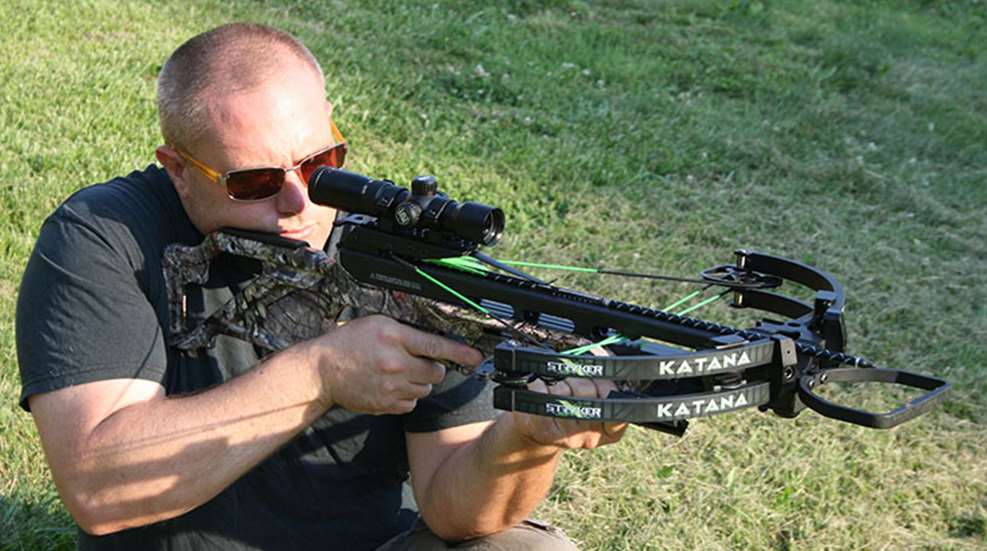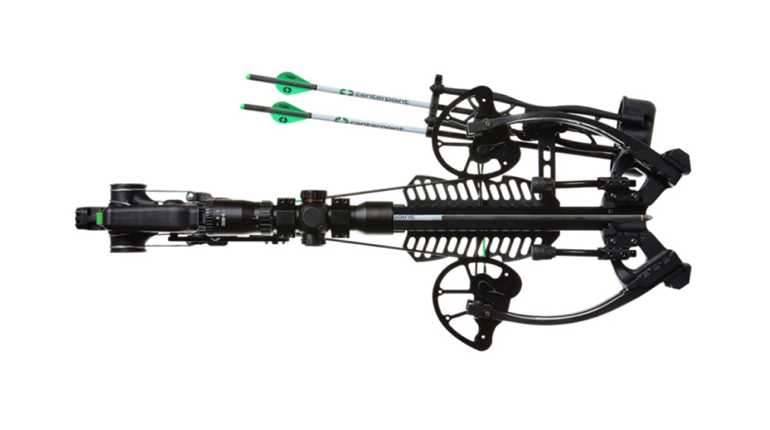
Times and trends change. This is especially true in crossbows. For instance, a few years ago there was unyielding one-upmanship in attaining the highest velocities. Some designs to emerge from this “need-for-speed” craze represented prowess, others absurd. This movement has subsided—to an extent. Now, the tendency is “efficiency”; that is, maximum velocities produced by smallish crossbows with tolerable draw weights. Stryker’s Katana 385, reviewed here, is illustrative of this new approach.
A conventional-draw crossbow, the Katana 385 has the aluminum riser affixed to the end of the rail. Typically, this results in a nose-heavy feel (even with a bullpup-style stock) and a protracted overall length, the latter of which negatively affects maneuverability in tight spaces. With an overall length of 35 inches, the Katana is only slightly longer than even compact, reverse-draw crossbows, and the extensively skeletonized aluminum rail reduces the weight up front, thereby lessening the forward-heavy feel. It’s obvious that Stryker did its homework.
Forethought also went into the attachment of the riser to the stock assembly (i.e. rail). Ardent crossbow shooters are well aware that, in time, the screws securing the abovementioned parts together can back out. As a hedge against inadvertent screw withdrawal, the Katana 385’s riser is secured from beneath by two flat-head screws and, on each side of the rail, another screw (one per side) provides insurance. A sling swivel stud is found on the bottom of the rail between the flat-head screws, and the second is integral to the buttstock.
As is indicated by its name, the Katana “385” is purported to attain 385 f.p.s. This is made possible via the combination of a split-limb bow with dual, semi-aggressive cams, 155-lb. draw weight, and a 13” power stroke. Axle-to-axle length is 19 3/16”. Cruise the Internet and you’ll quickly see how remarkable this feat was.
Evidence of Excalibur’s—remember, Stryker and Excalibur are but two of the companies beneath BowTech’s umbrella—influence is found not only on the Katana 385’s rail, but elsewhere, too. For example, the Katana 385’s two-position, bilateral, manual safety is the exact model used on Excalibur crossbows. It’s also utilized on the Stryker Offspring. Many crossbow users criticize anything but an automatic safety, a manual safety is no different than that found on a firearm; you must always engage the safety after loading. The up position represents “fire” and exposes a red dot, while the downward position is “safe.” According to Stryker, the single-stage trigger, which the company aptly coined “Kill Switch,” has less than 0.015” of travel and breaks at 2.5 lbs. of pull or less. On the sample crossbow, though, the trigger broke at 4 lbs., 2.1 ozs. after extensive travel. It could be improved.
Like Excalibur’s recurve-style crossbows, the Katana features the Guardian Anti-Dry-Fire system, which, as its name suggests, prevents dry firing the crossbow. Essentially a downward-projecting, spring-loaded tab, it only moves upward (and out of the way of the string) when there’s a bolt beneath it. It’s a simple way to protect the crossbow and user. Atop of the fire-control housing is an aluminum block with integral scope base to which the user mounts the provided Tact-Zone scope using the included Excalibur aluminum rings.
The scope is calibrated for crossbow velocities ranging from 300 to 410 f.p.s. and has aiming points in 10-yard increments. To use, simply select the bow’s actual velocity—preferably confirmed with a chronograph—on the magnification band and sight-in at 20 yards using the crosshair. Next, check that the aiming points at subsequent distances are correct, too; if not, make the necessary adjustments on the scope’s dials. On the sample Katana 385, once set to the actual velocity and zeroed at 20 yards, 50-plus-yard hits were easy. It’s a very accurate system.
The Katana 385’s polymer, camouflage-clad, thumbhole stock features a reversible cheek piece to accommodate both right- and left-handed shooters. On the fore-end there’s has a palm-filling swell with rubber inserts to enhance purchase in moist conditions. Above said swell the fore-end flares outward 1 1/8” on each side to prevent fingers from reaching the flight path of the string. When holding the crossbow properly, it’s difficult for a digit to reach the top of the rail—a good thing. Particularly nice is a pistol grip with a slight mid-length swell, rubber inserts, and oversize finger grooves. The length of pull is 14 7/16”.
Included in the Katana 385 package are: a four-bolt Excalibur quiver; four 20 1/2”-long Black Eagle Accustrike Light bolts and 100-gr. field points; an Excalibur rope cocking aid; and an Excalibur C2 crank cocking aid. At 155 lbs., the latter isn’t likely to be needed by many hunters, but will certainly be an asset to those with compromised strength. Keep in mind that the Katana requires moon nock or universal nock-quipped bolts at least 20” in length and weighing at least 350 grs. (with tip). Unlike Excalibur crossbows, flat nocks cannot be used.
In evaluating the Katana, I first chronographed it using one of the supplied bolts and field points that had a combined weight of 350.8 grs. Through a Competition Electronics chronograph placed at 5 feet, the Katana 385 attained a consistent (i.e. 0 Sd) 370-f.p.s. velocity for five consecutive shots, which resulted in 107 ft.-lbs. of energy. While slower than proclaimed 385 f.p.s., 370 f.p.s. is still plenty fast for hunting—especially when you consider the modest 155-lb. draw weight that enables said velocity. Concerning cocking, I found no need to use the C2 crank coking aid; it’s easy using the simple rope cocking aid to draw the string. I will say that the serving slipped slightly where the hooks of the cocking aid contacted the string. It was moved easily back into place, though.
Accuracy testing occurred from a bench at both 30 and 40 yards At those distances, three consecutive, three-shot groups averaged 1.28” and 2.13”, respectively. The smallest group—shot at 30 yards—measured slightly over an inch. A single, three-shot group at each of the same distances using 20 3/8”-long, 460-grain Easton Full Metal Jacket Crossbow bolts (with 100-grain field point installed) measured 1.53” and 2.09”, respectively.
It’s worthy of note that the Katana 385 doesn’t come with any noise-reduction accouterments, and it doesn’t need them, either. The bow is remarkably quiet as-is, which is a testament to its design.
In the end, the Stryker Katana 385 isn’t the fastest, lightest, or the most compact crossbow in the marketplace, but it does have the ideal balance of the aforementioned characteristics and a lightweight draw and respectable accuracy. For this reason, I find it to be a good option for all manner of hunters heading afield this fall.
Technical Specifications:
• Velocity: 385 f.p.s. (370-f.p.s. recorded)
• Draw Weight: 155 lbs.
• Power Stroke: 13”
• Trigger: single-stage; 4-lb., 2.1-oz. pull
• Barrel: aluminum Riser (of limb assembly): aluminum
• Safety: two-position manual
• Sights: none; Tact-Zone scope and rings included
• Finish: camouflage
• Stock: synthetic; length of pull, 14 7/16”
• Length: 35”
• Width: 19 3/16”
• Weight: 6.5 lbs.
• MSRP: $1,149





































